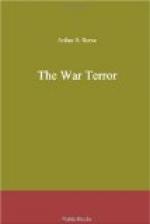I found that it could not be seen, though I tried all over the place and got myself disliked by the gardener and suspected by a watchman with a dog.
It could not have been from the tower of the boathouse that we had seen the light, and I hurried back to Craig to tell him so. But when I returned, I found that he was impatiently pacing the little rustic summerhouse, no longer interested in what he had sent me to find out.
“What has happened?” I asked eagerly.
“Just come out here and I’ll show you something,” he replied, leaving the summerhouse and approaching the boathouse from the other side of the hedge, on the beach, so that the house itself cut us off from observation from Carter’s.
“I fixed a lens on the top of that tower when I was up there,” he explained, pointing up at it. “It must be about fifty feet high. From there, you see, it throws a reflection down to this mirror. I did it because through a skylight in the tower I could read whatever was written by anyone sitting at Carter’s desk in the corner under it.”
“Read?” I repeated, mystified.
“Yes, by invisible light,” he continued. “This invisible light business, you know, is pretty well understood by this time. I was only repeating what was suggested once by Professor Wood of Johns Hopkins. Practically all sources of light, you understand, give out more or less ultraviolet light, which plays no part in vision whatever. The human eye is sensitive to but few of the light rays that reach it, and if our eyes were constituted just the least bit differently we should have an entirely different set of images.
“But by the use of various devices we can, as it were, translate these ultraviolet rays into terms of what the human eye can see. In order to do it, all the visible light rays which show us the thing as we see it—the tree green, the sky blue—must be cut off. So in taking an ultraviolet photograph a screen must be used which will be opaque to these visible rays and yet will let the ultraviolet rays through to form the image. That gave Professor Wood a lot of trouble. Glass won’t do, for glass cuts off the ultraviolet rays entirely. Quartz is a very good medium, but it does not cut off all the visible light. In fact there is only one thing that will do the work, and that is metallic silver.”
I could not fathom what he was driving at, but the fascination of Kennedy himself was quite sufficient.
“Silver,” he went on, “is all right if the objects can be illuminated by an electric spark or some other source rich in the rays. But it isn’t entirely satisfactory when sunlight is concerned, for various reasons that I need not bore you with. Professor Wood has worked out a process of depositing nickel on glass. That’s it up there,” he concluded, wheeling a lower reflector about until it caught the image of the afternoon sun thrown from the lens on the top of the tower.




